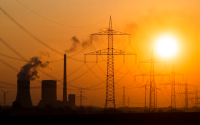24 May 2006People and Planet
Without significant gains from energy efficiency efforts,China, India and Brazil within a single human generation (by 2030) will more than double their energy use and greenhouse gas emissions, resulting in major impacts on global energy markets and climate, a World Bank study warns.
However, experts estimate that cost-effective retrofits could reduce those countries’ energy use today by at least 25 per cent and advanced technologies could reduce their energy use growth projected through 2030 by at least 10 per cent (and reduce projected CO2 emission growth by 16 per cent).
With world energy prices and climate-altering greenhouse gas emissions ballooning in tandem with a surge in energy demand from the hot economies of China, India and Brazil, the world has a major stake in the success of energy reduction efforts, particularly in those three countries, the experts said at the end of a our-year international project.
Unlocking today’s potential savings requires simple, highly cost-effective renovation projects to identify and eliminate energy waste, they said. The keys are fostering corporate awareness, supporting catalyst energy efficiency practitioners and enlightening commercial banks to ease access to local financing for such projects.
“Improving energy efficiency for existing buildings and other infrastructure could cut current energy consumption by 25 per cent or more in India, China and Brazil, amounting to millions of tonnes in reduced greenhouse gas emissions and hundreds of millions of dollars in energy savings,” says Robert Taylor, a World Bank Lead Energy Specialist and leader of the Three Country Energy Efficiency Project (3CEE).
Conclusions from the project were captured at a conference in Paris on May 19-20, involving the project’s public and private sector partners. An executive summary of those conclusions will be published online on May 29.
Despite the huge potential, it has been difficult to achieve investments on the ground so far, the project summary concludes.
"Many energy efficiency projects quickly pay for themselves, with typical returns on investment of 20-40 per cent," says Chandra Govindarajalu, a senior World Bank environmental specialist. “Despite the demonstrated benefits, though, companies often cite other, more immediate investment and borrowing priorities. Meanwhile, commercial banks in these countries are generally unfamiliar with financing projects designed to achieve cost savings, rather than develop new product lines or other tangible assets.”
Other roadblocks within companies include: Lack of awareness/experience with newer efficient technologies;High transaction costs for smaller sized projects that inhibit implementation;High perceived risk by decision makers; andA lack of combined technical and financial skills at finance institutions, preventing accurate appraisal and structuring of potential efficiency projects.
Saving energy
“Cutting energy waste is the cheapest, easiest, fastest way to solve many energy problems, improve the environment and enhance both energy security and economic development,” says Mr. Taylor. “What we must develop further are systems to tap huge potential energy savings through thousands of small projects scattered across China, India, Brazil, as well as smaller developing country economies,”
He says the reluctance of companies to undertake energy retrofits is akin to that of countless millions worldwide who fail to buy energy efficient light bulbs for homes, despite proof that they save enough in utility bills to more than pay for themselves.
“Even people who know the financial and environmental benefits of the bulbs may not buy and install them – it seems like such a small thing, why take the trouble? But from a national or global point of view, the potential savings add up to the electricity and pollution produced by many large power plants.
“Imagine, however,” Taylor says, “if I offered to install the efficient bulbs and guaranteed they would pay for themselves in six months or your money refunded. Perhaps then you might then buy a package.
“Rapidly developing countries such as China, India and Brazil need many people and consulting firms to do that same thing at the level of an industrial facility or apartment building, for example, to identify energy efficiencies across the board and exploit large-scale energy use reduction opportunities, and enlightened banks to finance them.”
Such retrofits involve installing, for example, high efficiency lighting, air conditioners, boilers and waste heat recovery systems for commercial and public buildings, industrial plants and other facilities. Project costs (and profits) can be provided to energy service companies (ESCOs), which design and implement energy conservation projects, or participating banks, from a share of utility bill savings.
"Money is available in these countries but can't be accessed easily by energy conservation promoters and ESCOs. This is a big area for work in the future” says Mark Radka, Head of the UNEP Energy Branch, based in Paris. “It takes time and effort for local businesses, banks, governments and aid organizations to develop energy conservation delivery systems which work and which can be supported by the financial community.”
While energy efficiency projects need to be customized to local circumstances and business practices, the project makes a host of recommendations, including: Foster the growth of ESCOs;Promote energy efficiency investments by local utilities; andDevelop special local bank lending arrangements to provide energy conservation financing.Initiated in 2001, the 3CEE Project has attempting to promote energy efficiency projects in China, India, Brazil by easing typical investment requirements of financial institutions.
The project is a joint initiative of the World Bank, the UN Environment Programme’s Denmark-based Risoe Centre (URC), and partners in Brazil, China and India. The UN Foundation and the World Bank Energy Sector Management Assistance Program provided financial support, with complementary activities supported by the Asia Alternative Energy Program and the UK Department for International Development.
“People worldwide have a vital interest in the success of this initiative to harness the power of the private sector to minimize the energy required for these three countries to realise their economic goals,” says Jyoti Painuly, Senior Energy Planner at the UNEP Risoe Centre on Energy, Climate and Sustainable Development.
Juan Zak, a project team member at the UNEP RISOE Centre, added: “Accelerated polar ice melting is the latest indication that severe climate change may be upon us. The current 380 parts per million of carbon dioxide in the atmosphere seem already too high. Roughly half of the global consumption of fossil fuels should be avoided if climate is to be stabilized. Using energy much more wisely is one of the very few feasible ways that, combined, would move the world towards this goal without economic disruption.”
Top consumersThe importance of improving energy efficiency in China, India and Brazil (with a combined 2.6 billion people, or almost 40 per cent of world population) is hard to overestimate.
China, India and Brazil, already rank among the world’s top 10 energy consumers with astonishing economic growth rates nearing 10 per cent per year; they are on track to becoming the world’s major greenhouse gas emitters. Although today they emit just 10 per cent as much greenhouse gas per capita as North America, their national emissions are rising far faster.
China's emissions, for instance, are expected to double by 2020, in which case China will surpass the US as the leading source of climate-altering gases. By one estimate, the China power market will require an average 48 gigawatts of new capacity every year, equal to two-thirds of the UK’s total installed capacity.
Global GDP is projected to more than double by 2030, 80 per cent of that growth accounted for by non-OECD countries, where current energy intensity of GDP (expressed as barrels of oil equivalent—BOE—per $1,000 of GDP) was approximately three times that of the OECD countries in 2005. Without gains in energy efficiency, such global GDP growth would raise daily global energy demand from 205 million BOE today to more than 500 million BOE by 2030.
Much of that energy in India and China will be supplied by coal. China is both the world’s largest coal consumer and producer. While coal in China’s overall energy mix is projected to decline from 66 per cent in 2002 to 41 per cent in 2030, its total CO2 emissions are still projected to increase from 3307 Mt to 7144 Mt.
India’s installed capacity for power generation has tripled over the last 20 years and now exceeds 101,000 MW. However, the total demand is expected to increase by another 3.5 times in the next two decades, even under a best-case scenario that envisions intensified efforts to modernize power plants, improve transmission and distribution efficiency, and adopt more efficient generation technologies.
India's soaring power demand will necessitate tripling installed generation capacity from 101,000 to 292,000 MW over the next two decades, much of it derived from poor quality coal. Similar demand increases are forecast for all fuels, and CO2 emissions are projected to increase from 1016 Mt to 2254 Mt by 2030.
The 3CEE report notes that improvements in energy efficiency will bring China, India and other coal-dependent countries the important additional benefits of cleaner air, better health and other environmental improvements.
Brazil's growing emissions
Brazil is the world’s 10th largest energy consumer, yet its fossil fuel CO2 intensity per unit of energy consumed is low due to widespread use of renewable energy from hydro electricity, ethanol and other biomass. However, Brazil's overall energy intensity (measured as energy consumption per dollar of GDP) has been increasing.
Fossil fuel intensity increased 18 per cent between 1990 and 2004, while electricity increased by 29 per cent. Brazil’s economic growth has been much slower than India’s or China’s over the past decade and projections are also much lower, hence projected energy supply increases are less dramatic – electricity consumption would increase 65 per cent (244 trillion kw/h) by 2015, assuming annual GDP growth of 4 per cent.
The International Energy Agency projects an increase in Brazil CO2 emissions of 302 Mt to 665 Mt by 2030.
“Energy efficiency in these three countries is a win-win strategy. It is one of the cleanest, cheapest and fastest ways to reduce carbon emissions,” says Timothy E. Wirth, President of the UN Foundation, which provided the project’s core funding.
After some initial success with ESCOs in China, the 3 CEE project has now moved on to help China develop lending programmes in local banks for large-scale energy efficiency projects, to be financed in part by a $200 million World Bank loan.
China has called for a "conservation society" and its commitment to a further 20 peer cent improvement in energy intensity over 2005 levels by 2010 and the project initiatives fit well with that objective. The topic of energy efficiency is now granted special attention (along with “energy development”) in all of China’s energy-related planning. The project report highlights potential savings as well in the industrial, construction and transportation sectors.
Hopefully other countries will see that success and create a similar programs to meet their needs and apply it to other natural resource areas such as water where inefficiencies are equally high Mr Taylor says.New approaches
India’s potential energy efficiency market is estimated at more than US $3.1 billion, which would produce a savings of 54 terawatt hours per year. To help realize this impressive potential, the Indian Government established a Bureau of Energy Efficiency (BEE) and, the Bank says, a variety of commercial interests are beginning to pick up the energy efficiency business. But more support and financial backing is required.
Brazil’s annual untapped energy savings potential is estimated at US$ 2.25 billion and many projects would enjoy an average payback of less than 30 months.
Brazil’s has a strong national ESCO association (ABESCO)and is also among the few developing countries to have established a “wire charge,” which streams a small portion of power companies’ revenues into energy conservation. At the Paris meeting, the Brazilian Development Bank (BDNES) announced a new guarantee programme to assist ESCOs and accept 80 per cent of loan risks on accepted energy reduction projects.“






